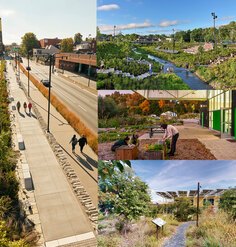From the Field: Over, Under, and Through - A Texas Three-Step of Landscape Performance
By Sameepa Kashyap Modi, MLA Candidate, Dylan Stewart, MLA Candidate, and Taner R. Ozdil, Ph.D., Assistant Professor, School of Architecture, University of Texas at Arlington
Home to two of the top five largest metropolitan areas in the U.S. (Dallas and Houston), Texas is witness to many unique and innovative landscape architecture projects that respond to the growing needs of an urbanizing population. With the University of Texas at Arlington’s location in the heart of Dallas-Fort Worth Metropolitan Region, we are well-situated to analyze and document the environmental, economic, and social performance of three such projects with help from our professional partners.
Office of James Burnett’s Klyde Warren Park
By decking over a 5.2-acre stretch of freeway, Klyde Warren Park in Dallas transforms one of the most inhumane settings into a thriving, open public space that connects the Uptown and Arts Districts to downtown. The park offers an engaging mix of spaces for recreation and relaxation. A critical performance measure is the social benefit that the park provides. To gauge users’ perceptions of the park, our research team developed and administered a survey with categories like physical health, quality of life, and educational opportunities. From our onsite observations, it is clear that the mere availability of this space among the Dallas high-rises creates not only real estate value but also a sense of relief and joy for residents and visitors alike.
SWA’s Buffalo Bayou Promenade
This 23-acre greyfield redevelopment project in Houston transforms a neglected and disconnected stretch of the Buffalo Bayou waterway, which passes beneath various freeway and street bridges. The new 1.2-mile linear park features extensive green infrastructure to increase flood storage capacity and a comprehensive trail network that provides an accessible and scenic outlet for recreation. The reclamation of the waterfront has also prompted property owners adjacent to Buffalo Bayou to embrace this natural resource.
PWP’s UT Dallas Campus Identity and Landscape Framework Plan
Growth at the University of Texas at Dallas campus was beginning to feel stunted by the acres and acres of hardscape and a student population defined as ‘vehicle-oriented.’ The Campus Identity and Landscape Framework Plan envisions a landscape that students will want to be part of, outside of the classroom. Phase 1 of the plan created a 33-acre spine with sculptural magnolia trees, cooling aesthetic reflecting pools, and a native rain garden that stretches from the main entrance to the expansive mall that defines the heart of the campus. Preliminary research results indicate that the reflective heat is greatly reduced via the rigorous landscape plan, creating a much more pleasant campus environment. By investing in high-quality landscapes, the university hopes to not only improve the campus experience but also to increase enrollment, which will help in its quest to be recognized as a Tier 1 university.
While these three large landscape projects are very distinct, all three are noteworthy for their sensitivity to create a sense of place and their search for economic viability in their own context. Our research team hopes that the knowledge and lessons we discover through the rigorous examination of these landmark projects will inform future landscapes in other urbanizing areas.
Research Fellow Taner R. Ozdil and student Research Assistants Dylan Stewart and Sameepa Kashyap Modi are participating in LAF’s 2013 Case Study Investigation (CSI) program and working to document the performance of three exemplary landscape projects in Texas. Any opinions expressed in this article belong solely to the author. Their inclusion in this article does not reflect endorsement by LAF.










